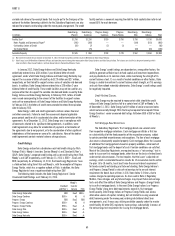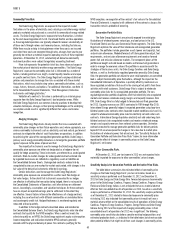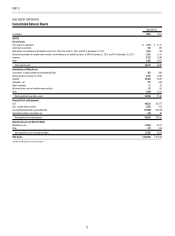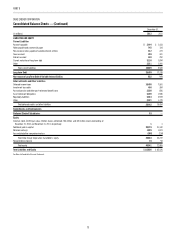Duke Energy 2012 Annual Report Download - page 87
Download and view the complete annual report
Please find page 87 of the 2012 Duke Energy annual report below. You can navigate through the pages in the report by either clicking on the pages listed below, or by using the keyword search tool below to find specific information within the annual report.
67
PART II
its fuel supply so it can continue to provide its customers with an uninterrupted
supply of electricity. The Duke Energy Registrants have a program in place to
effectively manage the impact of future droughts on its operations.
Other EPA Regulations Recently Published and Under Development
The EPA has issued and is in various stages of developing several non-
greenhouse gas (non-GHG) environmental regulations that will affect the Duke
Energy Registrants. These include the fi nal Mercury and Air Toxics Standards
(MATS) for hazardous air pollutants, which is effective beginning in 2015, as
well as proposed regulations for cooling water intake structures under the Clean
Water Act 316(b) and proposed regulations for coal combustion residuals.
As a group, these non-GHG environmental regulations will require the Duke
Energy Registrants to install additional environmental controls and accelerate
retirement of some coal-fi red units. While the ultimate regulatory requirements
for the Duke Energy Registrants from the group of EPA regulatory actions will
not be known until all the rules have been fi nalized, for planning purposes, the
Duke Energy Registrants currently estimate the cost of new control equipment
that may need to be installed to comply with this group of rules could total
$5 billion to $6 billion, excluding AFUDC, over the next 10 years. This range
includes estimated costs for new control equipment necessary to comply with
the MATS of $650 million to $800 million. The Duke Energy Registrants also expect
to incur increased fuel, purchased power, operation and maintenance, and other
expenses in conjunction with the non-GHG EPA regulations. In addition to the
plant retirements associated with new generation the Duke Energy Registrants are
constructing, the Duke Energy Registrants are planning to retire additional coal
fi red generating capacity that is not economic to bring into compliance with the
EPA’s regulations. Beyond 2012, total planned and potential retirements could
exceed 3,900 MW of coal-fi red generating capacity. The Duke Energy Registrants
would also expect to incur costs for replacement generation as a result of the
potential coal-fi red power plant retirements. Until the fi nal regulatory requirements
of the group of EPA regulations are known and can be fully evaluated, the potential
compliance costs associated with these EPA regulatory actions are subject to
considerable uncertainty. Therefore, the actual compliance costs incurred and MW
to be retired may be materially different from these estimates based on the timing
and requirements of the fi nal EPA regulations.
For additional information, see Note 4 to the Consolidated Financial
Statements, “Regulatory Matters” and Note 5 to the Consolidated Financial
Statements, “Commitments and Contingencies.”
Nuclear Matters
Following the events at the Fukushima Daiichi nuclear power station
in Japan, Duke Energy conducted thorough inspections at each of its four
nuclear sites during 2011. Progress Energy also conducted inspections
in 2011 at each of its three sites. The initial inspections have not identifi ed
any signifi cant vulnerabilities, however, Duke Energy is reviewing designs to
evaluate safety margins to external events. Emergency-response capabilities,
written procedures and engineering specifi cations were reviewed to verify each
site’s ability to respond in the unlikely event of station blackout. Duke Energy
is working within the nuclear industry to improve the safety standards and
margin using the three layers of safety approach used in the U.S.: protection,
mitigation and emergency response. Emergency equipment is currently being
added at each station to perform key safety functions in the event that backup
power sources are lost permanently. These improvements are in addition to the
numerous layers of safety measures and systems previously in place.
In March 2011, the NRC formed a task force to conduct a comprehensive
review of processes and regulations to determine whether the agency should
make additional improvements to the nuclear regulatory system. On July 13,
2011, the task force proposed a set of improvements designed to ensure
protection, enhance accident mitigation, strengthen emergency preparedness
and improve effi ciency of NRC programs. The recommendations were further
prioritized into three tiers based on the safety enhancement level. On March 12,
2012, the NRC issued three regulatory orders requiring safety enhancements
related to mitigation strategies to respond to extreme natural events resulting in
the loss of power at a plant, ensuring reliable hardened containment vents and
enhancing spent fuel pool instrumentation.
In May 2012, the NRC endorsed guidance on re-evaluating emergency
communications systems and staffi ng levels and performing seismic and
fl ooding walkdowns. On July 13, 2012, the NRC outlined plans for implementing
Tier 2 and Tier 3 recommendations. On August 30, 2012, the NRC issued
implementation guidance to enable power plants to achieve compliance with the
orders issued in March 2012. Plants are then required to submit implementation
plans to the NRC by February 28, 2013, and complete implementation of the
safety enhancements within two refueling outages or by December 31, 2016,
whichever comes fi rst. Each plant is also required to reassess their seismic
and fl ooding hazards using present-day methods and information, conduct
inspections to ensure protection against hazards in the current design basis,
and re-evaluate emergency communications systems and staffi ng levels.
Duke Energy is committed to compliance with all safety enhancements
ordered by the NRC in connection with the March 12, 2012, regulatory orders
noted above, the cost of which could be material. Until such time as the NRC
mandated reassessment of fl ooding and seismic hazards is complete the exact
scope and cost of compliance modifi cations to our sites will not be known. With
the NRC’s continuing review of the remaining recommendations, Duke Energy
cannot predict to what extent the NRC will impose additional licensing and
safety-related requirements, or the costs of complying with such requirements.
The tight time frame required to complete the necessary safety enhancements
by no later than 2016 could lead to even higher costs. Upon receipt of additional
guidance from the NRC and a collaborative industry review, Duke Energy will be
able to determine an implementation plan and associated costs. See Item 1A,
“Risk Factors,” for further discussion of applicable risk factors.
New Accounting Standards
See Note 1 to the Consolidated Financial Statements, “Summary
of Signifi cant Accounting Policies” for a discussion of the impact of new
accounting standards.
ITEM 7A. QUANTITATIVE AND QUALITATIVE DISCLOSURES ABOUT MARKET RISK
See “Management’s Discussion and Analysis of Results of Operations and Financial Condition, Quantitative and Qualitative Disclosures About Market Risk.”
























